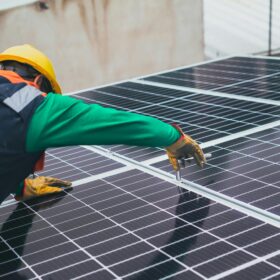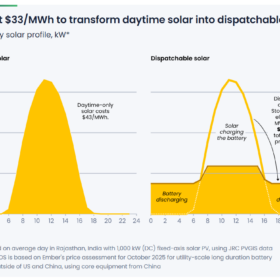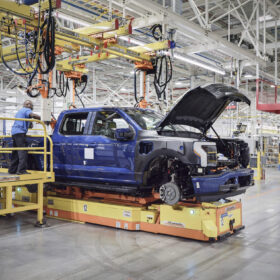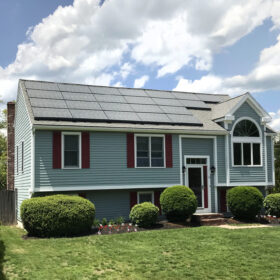The looming direct-current (DC) voltage shift from the solar industry standard 1.5 kV to 2 kV, like the previous step up from 600 V, promises cost savings and efficiency gains. It will again challenge PV manufacturers and developers, who must weigh technical advancement and specialist products against economic viability.
Some have already found the balance in 2 kV’s favor. A 182 MW, 2 kV project was built in China in 2023 and at least one US pilot site was operating in 2024.
Why 2 kV?
In principle, higher voltage enables more power transmission at the same or a proportionally lower current while minimizing energy losses. Higher currents require thicker cables, making increasing voltage cheaper than raising current.
While electrical engineer equations get tougher, as alternating current (AC) and reactive power are considered, DC logic is straightforward: power equals current times voltage, or P=IV.
Therefore, increasing the voltage while maintaining or reducing current either increases or maintains power output with fewer losses. For solar, the transition is expected to improve energy yields by 0.5% to 0.8%.
Energy yield is only part of the story, however. At 2 kV, systems can accommodate 33% more modules per string than at 1.5 kV as the voltage drop over the modules is reduced, if the same sized conductor is used. Shorter strings may mean thinner copper conductors, too, delivering savings.
Fewer strings mean fewer “home run” power trunk lines between site and inverter. That brings a 10% to 15% equipment saving from fewer combiner boxes, connectors, and cabling – and cheaper maintenance.
Manufacturers step up
The shift to 2 kV is not simply swapping out components or re-rating, though. It requires an industry transition.
China’s JinkoSolar became the first PV module supplier to be certified by standards body UL Solutions for 2 kV-supporting products.
“The actual core circuit of the module stays the same as a standard module. What the higher voltage rating does is allow you to make the strings longer. For getting the PV module to 2 kV, UL has published guidance on the creepage [the shortest distance between two conducting points along the surface of an insulating material] and clearance [the shortest distance in the air between two conducting parts] requirements, which essentially make the module slightly bigger. Meaning, you need more material between the edge of the active circuit of the laminate and the edge of the laminate,” said Adam Detrick, director of product management and technical services at JinkoSolar US.
“We utilize a unique encapsulant that can withstand the increased impulse voltage required on 2 kV. There are also slight modifications to the J-box [junction box] and connectors. On the connector side, it’s mostly the insulation material itself, where we added a higher dielectric material on the plastic housing. And the J-box has some increased creepage and clearance requirements as that voltage goes up.”
Inverter manufacturers face topography changes and efficiency loss. Higher voltages put greater stress on inverter semiconductor switches, causing switching losses and affecting long-term reliability. Inverter companies pv magazine spoke to said the challenges are well understood.
“Technically speaking, shifting to 2 kV is not a humongous challenge. It’s a matter of clearance distances and making sure new components can withstand the increased voltages, and insulation levels have to be increased,” said Damian Perez de Larraya, head of product management and business development at ABB-owned inverter maker Gamesa Electric. “Plus, cooling needs to be updated and with water cooling that is a challenge, but one we can face.”
Finding components is another hurdle. “We are testing different strategies for our designs and topologies and we have decided on what we want to build,” said Perez de Larraya. “The thing we are waiting for is certified components. Not in the inverter IGBTs [insulated gate bipolar transistors], which we can source, but other materials. But overall reliability should not at all be penalized for 2 kV, though inverter efficiency may fall some small, fractional percentage.”
Electrical balance of systems (EBOS) also requires higher safety precautions at 2 kV.
“Shoals’ flagship patented trunk bus solution, the Big Lead Assembly (BLA), integrates the functionality of cable assemblies, fusing, and combiner boxes into a single system,” said Jeff Tolnar, CEO and president of EBOS provider Shoals Technologies, a pv magazine Award 2024 winner for its 2 kV cabling. “With the release of 2 kV standards by UL, components in our BLA system have been re-rated and are undergoing certification to handle 2,000 volts. Our rigorous factory testing ensures that our solutions not only meet certification requirements but also exceed industry safety standards.”
First mover disadvantage?
Solar investors want to see proof that the 2 kV transition will deliver the promised savings.
“It’s a bit early on and what happens with this industry is that all the players are different. The biggest have their own funding and tax equity sleeves and they’re able to sort of take on a little bit more risk and adapt earlier because they’re not governed by the requirements of institutions,” said Matt Murphy, chief operating officer (COO) of Greenbacker. “Partnerships at Greenbacker for tax equity and debt are very large banks, and these very large banks usually are not excited about being the first people to do something in the industry. So for us, in the next wave of acquisitions we intend to make, call it by 2026, we’ll start seeing 2 kV systems. And we expect by then that the banks and other entities and all of the parties around the institutions will be at least cautiously comfortable with them to the point where we’ll start integrating them.”
Demonstrable savings are key. “We’re technology-forward in operating and building our sites. But where we’re really focused is that when any new technology comes out that promises higher power and cheaper installation, it’s about proving that in practice. So, we’re laser-focused not on if it appears to be more cost-efficient, but does it actually make a project more cost-efficient?” said Murphy. “If we go to 2 kV, are our EPCs [engineering, procurement, and construction service providers] actually charging us less? Are we seeing less on our O&M [operations and maintenance] contracts? There’s a real difference in the industry between perceived savings and actual savings. It can be much different in practice. And it’ll eventually prove itself through price discovery, when EPCs come back to us and show they’re in on it and can deliver installation savings. Right now, we can’t say that one way or the other.”
JinkoSolar’s Detrick said that it is now up to the EPCs to begin designing the systems and determine if the expected cost benefits materialize. “I think EPCs and developers will be the ones driving demand for this over time,” he added.
Repowering challenges
Upgrading solar project generation capacity, common in the United States for tax reasons, may be complicated by 2 kV.
“In the US it can make a lot of sense to repower sites instead of doing major maintenance,” said Murphy. “And that’s really where this gets complicated with higher voltages. For standard systems, the more complicated and costly repowering those systems gets, so repowering a system from 600 V to 1,500 V, maybe it does work, but 2,000 V pushes things. The more equipment you can reuse, the more sense it makes for repowering. For a company like Greenbacker, those repowering projects are often a no-brainer.”
Stifling regulation
Europe, Asia, and Australia offer regulatory challenges to 2 kV not present in China or the United States.
In Europe, legislation from 1973 defines AC low voltage as 50 V to 1 kV and DC as 75 V to 1.5 kV. Hence, 2 kV systems face legal hurdles. Changing the regulation would be time-consuming and require adoption by EU member states.
Asia has a variety of high-voltage DC regulations. In Japan, mains power is only 100 V, meaning 1.5 kV and 2 kV DC power are already bracketed together, potentially meaning minimum fuss from a switch.
In Australia, national regulations define high voltage as exceeding 1 kV AC or 1.5 kV DC. Therefore, 2 kV DC systems fall under the high voltage classification and require adherence to more stringent safety regulations. As in Europe, that adds another layer of complexity to 2 kV system implementation and is a drag on the industry.
Despite the challenges, the shift to 2 kV appears inevitable. S&P Global forecasts 2 kV systems will make up 77% of utility-scale solar projects globally by 2030, increasing from under 5 GW in 2026 to 380 GW. China and the United States are expected to lead the transition.
China’s rapid development cycles and large manufacturers give it an edge in implementing new technology while the US market is also gearing up for 2 kV with multiple companies having announced certification for their products in 2024.
This content is protected by copyright and may not be reused. If you want to cooperate with us and would like to reuse some of our content, please contact: editors@pv-magazine.com.









By submitting this form you agree to pv magazine using your data for the purposes of publishing your comment.
Your personal data will only be disclosed or otherwise transmitted to third parties for the purposes of spam filtering or if this is necessary for technical maintenance of the website. Any other transfer to third parties will not take place unless this is justified on the basis of applicable data protection regulations or if pv magazine is legally obliged to do so.
You may revoke this consent at any time with effect for the future, in which case your personal data will be deleted immediately. Otherwise, your data will be deleted if pv magazine has processed your request or the purpose of data storage is fulfilled.
Further information on data privacy can be found in our Data Protection Policy.